Devon and Somerset Fire and Rescue Service
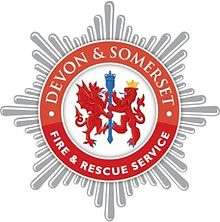 | |
| Operational area | |
|---|---|
| Country |
|
| Country |
|
| Counties | |
| Agency overview | |
| Employees | 2,300 |
| Facilities and equipment | |
| Stations | 85 |
| Website | |
| Official website | |
Devon and Somerset Fire and Rescue Service is the statutory fire and rescue service covering the counties of Devon and Somerset, including the unitary authorities of Plymouth and Torbay, in South West England. It is the fifth largest fire and rescue service in the United Kingdom.[1]
Devon and Somerset Fire and Rescue Service was founded on 1 April 2007, following the merger of Devon Fire and Rescue Service with Somerset Fire and Rescue Service.[1] The Somerset service, previously known as Somerset Fire Brigade, was formed on 1 April 1948. Devon Fire Brigade was formed in 1973, by the amalgamation of Exeter City Brigade, Plymouth City Brigade and Devon County Brigade. It became Devon Fire and Rescue Service in 1987.
It is organised operationally into three commands: Central, Western and Somerset. The service's main headquarters is located at Clyst St George near Exeter. Its main training centre is the Service Training Centre (STC) at Plympton fire station. The service employs approximately 1,983 staff, including 624 whole time firefighters and 46 control room staff, 1,032 retained firefighters and 281 non-uniformed staff.
Each county operated its own control room until 2012 but they now have a single control room at Service Headquarters, Exeter. As part of a national FiReControl project, Devon and Somerset Fire and Rescue's control rooms were planned to switch to a regional control centre in Taunton but the plan was scrapped entirely in December 2010 by the Government.[2]
Fire Stations/Appliances

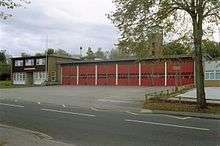
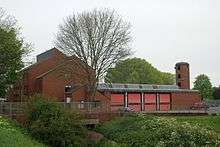

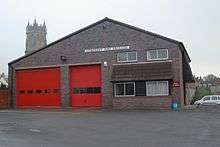

| Station Number | Station Name | Duty System | Appliances |
|---|---|---|---|
| 01 | Barnstaple | Wholetime/Retained | 1x WrL, 1x WrT, 1x WrC, 1x ALP, 1x L4V, 1x SRU, 1x LUV |
| 03 | Appledore | Retained | 1x LRP |
| 04 | Bideford | Retained | 1x WrL, 1x WrT |
| 05 | Braunton | Retained | 1x WrL |
| 06 | Chulmleigh | Retained | 1x WrL |
| 07 | Combe Martin | Retained | 1x WrL |
| 08 | Hartland | Retained | 1x WrL, 1x ERU |
| 09 | Hatherleigh | Retained | 1x WrL, 1x ERU |
| 10 | Holsworthy | Retained | 1x WrL, 1x ERU |
| 11 | Lynton | Retained | 1x WrL, 1x RRP, 1x ERU |
| 12 | North Tawton | Retained | 1x WrL, 1x EPU |
| 13 | Okehampton | Retained | 2x WrL, 1x L4P, 1x IRU |
| 14 | South Molton | Retained | 1x WrL, 1x EPU |
| 15 | Torrington | Retained | 1x WrL |
| 16 | Woolacombe | Retained | 1x WrL, 1x ERU |
| 17 | Torquay | Wholetime/Retained | 2x WrL, 1x LRP, 1x WrC, 1x L4P, 1x ALP, 1x LUV |
| 18 | Paignton | Wholetime/Retained | 1x WrL, 1x WrT |
| 19 | Ashburton | Retained | 1x WrL |
| 20 | Bovey Tracey | Retained | 1x WrL, 1x L4P, 1x IRU |
| 21 | Brixham | Retained | 1x WrL, 1x LRP |
| 22 | Buckfastleigh | Retained | 1x WrL |
| 23 | Chagford | Retained | 1x WrL, 1x ERU |
| 24 | Dartmouth | Retained | 1x WrL, 1x WrT |
| 25 | Dawlish | Retained | 1x WrL, 1x L4P, 1x ERU |
| 26 | Kingsbridge | Retained | 1x WrL |
| 27 | Moretonhampstead | Retained | 1x WrL, 1x ERU |
| 28 | Newton Abbot | Retained | 1x WrL, 1x WrT, 1x EPU |
| 29 | Salcombe | Retained | 1x LRP |
| 30 | Teignmouth | Retained | 1x WrL, 1x WrT |
| 31 | Totnes | Retained | 1x WrL, 1x WrT, 1x L4P, 1x ICU |
| 32 | Danes Castle, Exeter | Wholetime/Retained | 1x WrL, 1x WrT, 1x F/WrC, 1x ALP, 1x LUV |
| 33 | Exmouth | Wholetime/Retained | 1x WrL, 1x RRP, 1x L4P, 1x ICU |
| 34 | Axminster | Retained | 1x WrL, 1x ERU |
| 35 | Bampton | Retained | 1x WrL |
| 36 | Burleigh Salterton | Retained | 1x WrL |
| 37 | Colyton | Retained | 1x WrL |
| 38 | Crediton | Retained | 1x WrL, 1x LRP, 1x ERU, 1x PM+ISU |
| 39 | Collompton | Retained | 1x WrL, 1x L4P |
| 40 | Honiton | Retained | 2x WrL, 1x HLU |
| 41 | Ottery St Mary | Retained | 1x WrL |
| 42 | Seaton | Retained | 1x WrL, 1x ERU |
| 43 | Sidmouth | Retained | 1x WrL, 1x WrT |
| 44 | Tiverton | Retained | 1x WrL, 1x LRP |
| 45 | Topsham | Retained | 1x WrL, 1x WrT |
| 46 | Witheridge | Retained | 1x WrL |
| 47 | Plympton | Retained | 1x WrL, 1x WrC, 1x PM+BFU, 1x LUV |
| 48 | Camels Head | Wholetime | 1x WrL, 1x WrT, 1x L4V, 1x SRU, 1x IrbT |
| 49 | Crownhill | Wholetime/Retained | 1x WrL, 1x LRP, 1x ALP |
| 50 | Greenbank | Wholetime | 1x WrL, 1x LRP, 1x ICU |
| 51 | Plymstock | Retained | 1x LRP, 1x FB |
| 52 | Bere Alston | Retained | 1x WrL |
| 53 | Ivybridge | Retained | 1x WrL, 1x ERU, 1x PM |
| 54 | Kingston | Volunteer | 1x RRP |
| 55 | Modbury | Retained | 1x WrL |
| 56 | Princetown | Retained | 1x RRP, 1x ERU |
| 57 | Tavistock | Retained | 1x WrL, 1x WrT, 1x HLU, 1x L4V |
| 58 | Yelverton | Retained | 1x WrL |
| 59 | Middlemoor, Exeter | Wholetime | 1x WrL, 1x L4P, 1x HRU |
| 60 | Clyst St George/HQ (USAR) | Wholetime/Retained | 1x CSU, 3x L4V, 1x SRU, 2x SDU, 1x GPV, 1x LUV, 1x PCV, 4x PM, Modules: 1, 2, 3, 4, 5, pods: 1x HVP, 1x HVHL, 1x MDD |
| 61 | Taunton | Wholetime | 1x WrL, 1x LRP, 1x WrT, 1x ALP, 1x L4V, 1x ISU, 1x EPU, 1x IRU, 2x PM*, pods: 1x HVP, 1x HVHL, 1x MDR |
| 62 | Bridgwater | Wholetime/Retained | 2x WrL, 1x LRP, 1x WrC, 1x ALP, 1x L4V, 1x SRU |
| 63 | Burnham-on-Sea | Retained | 1x WrL, 1x LRP, 1x L4V, 1x PM, pods: 1x BFU, 1x WFU |
| 64 | Dulverton | Retained | 1x WrL, 1x L6P, 1x L4V, 1x ERU |
| 65 | Glastonbury | Retained | 1x RRP, 1x HRU, 1x L4V |
| 66 | Minehead | Retained | 1x WrL, 1x RRP, 1x L4P |
| 67 | Nether Stowey | Retained | 1x RRP, 1x L4P, 1x ATV |
| 68 | Porlock | Retained | 1x WrL, 1x L4P, 1x ERU, 1x ATV |
| 69 | Street | Retained | 1x WrL, 1x CSU |
| 70 | Wellington | Retained | 1x WrL, 1x LRP, 1x L4V |
| 71 | Williton | Retained | 1x WrL, 1x WrT, 1x L4V, 1x ERU |
| 72 | Wiveliscombe | Retained | 1x WrL, 1x CSU |
| 73 | Yeovil | Wholetime | 1x WrL, 2x WrT, 1x WrC, 1x ALP, 1x L4V, 1x ISU |
| 74 | Castle Cary | Retained | 1x WrL, 1x L4V |
| 75 | Chard | Retained | 1x WrL, 1x WrT, 1x L4V |
| 76 | Cheddar | Retained | 1x WrL, 1x L6P, 1x L4V, 1x ERU |
| 77 | Crewkerne | Retained | 1x WrL, 1x L4V |
| 78 | Frome | Retained | 1x WrL, 1x WrT, 1x L4V |
| 79 | Ilminster | Retained | 1x WrL, 1x L4V |
| 80 | Martock | Retained | 1x WrL, 1x L6P, 1x L4V |
| 81 | Shelton Mallet | Retained | 1x WrL, 1x WrT, 1x L4P |
| 82 | Somerton | Retained | 1x WrL, 1x L4V |
| 83 | Wells | Retained | 1x WrL, 1x LRP, 1x L4P |
| 84 | Wincanton | Retained | 1x WrL, 1x L4V |
| 85 | Lundy Island | Volunteer | 1x L4V, 1x WrB, 1x TrP |
Fire Appliance Glossary
- Water Ladder (WrL): P1 / P3
- Water Tender (WrT): P2 / P5
- Rural Response Pump (RRP): P1 /P2
- Light Rescue Pump (LRP): P1 / P2
- Light 6x6 Pump (L6P): P9
- Aerial Platform Ladder (ALP): A1
- Fire Boat (FB): B1
- Command Support Unit (CSU): C1
- Environmental Protection Unit (EPU): H2
- Light 4x4 Pump (L4P): M1
- Light 4x4 Vehicle (L4V): M5 / R2 / T5
- Heavy Rescue Unit (HRU): R1
- Specialist Rescue Unit (SRU): R5
- Incident Support Unit (ISU): S4
- Light Utility Vehicle (LUV): T2
- Prime Mover (PM): T2 / T8 / T9
Pods:
- Bulk Foam Unit (BFU)
- High Volume Pump (HVP)
- High Volume Hose Layer (HVHL)
- Incident Support Unit (ISU)
- Hose Layer Unit (HLU): W1
- Water Carrier (WrC): W1 / W3
- Co-Responder/Emergency Response Unit (ERU): V1 / V3
Trailers
- All Terrain Vehicle (ATV)
- Inshore Rescue Boat (IrbT)
- Pump (TrP)
- Water Bowser (WrB)
Urban Search & Rescue (USAR):
- Command Support Unit (CSU): C1
- Light 4x4 Vehicle (L4V): M5 / M6 / R2
- Specialist Rescue Unit (SRU): R5
- Search & Rescue Dog Unit (SDU): R8 / R9
- General Purpose Vehicle (GPV): T1
- Light Utility Vehicle (LUV): T2
- Personnel Carrier Vehicle (PCV): T3
- Prime Mover (PM): T6 / T7 / T8 / T9
Modules:
- Module 1 - Technical Search Equipment
- Module 2 - Heavy Transport, Confined Space & Hot Cutting Equipment
- Module 3 - Breaching & Breaking Equipment
- Module 4 - Multi Purpose Vehicle
- Module 5 - Shoring Operations
CBRN Response:
- Incident Response Unit (IRU): H9
- Prime Mover + Mass Decontamination Disrobe (PM+MDD): T9
- Prime Mover + Mass Decontamination Rerobe (PM+MDR): T9
Co-Responder
Devon and Somerset Fire and Rescue Service works in partnership with South Western Ambulance Service to provide emergency medical cover to areas of Devon and Somerset. These are areas that have been identified as having a greater need for ambulance cover. The aim of a co-responder team is to preserve life until the arrival of either a Rapid Response Vehicle (RRV) or an ambulance. Co-responder vehicles are equipped with oxygen and automatic external defibrillation (AED) equipment.[3]
Co-responder stations have a dedicated vehicle for Co-responder calls. The vehicle, known as the emergency response unit (EMS), attends in place of the fire appliance, (providing there are enough crew still on duty), allowing the fire appliance to remain available. Nineteen stations operate as co-responders:
- Axminster 34
- Chagford 23
- Cheddar 76
- Combe Martin 07
- Crediton 38
- Dawlish 25
- Dulverton 64
- Hartland 08
- Hatherleigh 09
- Holsworthy 10
- Ivybridge 53
- Lynton 11
- Moretonhampstead 27
- Nether Stowey 67
- Porlock 68
- Princetown 56
- Seaton 42
- Williton 71
- Woolacombe 16
Station grounds
M5 motorway
The M5 motorway is the arterial route through Devon and Somerset. It is the main link road to the south west from the Midlands and the North. Devon and Somerset Fire and Rescue Service divide the M5 into sections so that the nearest appliances attend. The station grounds are:
- Northbound - Bravo
- J31–J30 : 59 Middlemoor
- J30–J29 : 59 Middlemoor
- J29–J28 : 59 Middlemoor
- J28–J27 : 39 Cullompton
- J27–J26 : 39 Cullompton
- J26–J25 : 70 Wellington
- J25–J24 : 61 Taunton
- J24–J23 : 62 Bridgwater
- J23–J22 : 62 Bridgwater
- J22–J21 : 63 Burnham-On-Sea
- Southbound - Alpha
- J21–J22 : Avon FRS 18 Weston-super-Mare
- J22–J23 : 63 Burnham-On-Sea
- J23–J24 : 62 Bridgwater
- J24–J25 : 62 Bridgwater
- J25–J26 : 61 Taunton
- J26–J27 : 70 Wellington
- J27–J28 : 39 Cullompton
- J28–J29 : 59 Middlemoor
- J29–J30 : 59 Middlemoor
- J30–J31 : 59 Middlemoor
HMNB Devonport
HMNB Devonport Dockyard, in Plymouth, is home to twenty one of the Royal Navy's fleet of ships and submarines.
The dockyard falls into the station ground of 48 Camels Head, and is backed up by 49 Crownhill. Each part of the dockyard is divided into risk areas - this then reflects in the level of attendance by the Fire Service.
Some parts of the dockyard are considered a very high risk - therefore attract a high attendance - sometimes as many as four pumping appliances and the aerial ladder platform are mobilised to a fire alarm actuating; in contrast to one pumping appliance to a town dwelling.
Hinkley Point
Hinkley Point is a headland on the coast of Somerset. It is the location of two nuclear power stations (Hinkley Point A, which closed in 2000, and Hinkley Point B). Hinkley Point B is the only active site. Hinkley Point has its own fire station, backed up by 67 Nether Stowey and would then be backed up by 62 Bridgwater. There is a planned new nuclear power station that will be Hinkley Point C.
Fire appliances
Devon and Somerset use a variety of front-line and special appliances.[4]
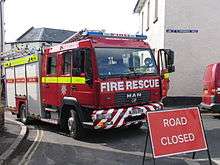
Water tender ladder (WrL)
A water tender ladder's major capabilities include pumping up to 3,000 litres (660 gallons) per minute between two locations. It has a storage capacity of 1,800 litres (396 gallons). The pump carries a range of ladders up to 13.5 metres (44 ft). Inside the cab are four sets of compressed air breathing apparatus. Each pump has several lockers on the external of the pump. Inside there is a set of powered hydraulic rescue equipment, a thermal imaging camera, water rescue equipment, a positive pressure ventilation fan and safety at height equipment. There are occasions when a Water Tender, and not the Water Tender Ladder, would be mobilised first. To keep the Water Tender Ladder 'on the run' and available; the Water Tender may attend incidents where a house is flooded or where someone has locked themselves out.
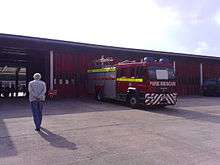
Water tender (WrT)
These appliances are broadly similar to the water tender ladders, but carry a different range of equipment, with ladders up to 10.5 metres (34 ft). They are not the primary responder to a road traffic collision - despite carrying hydaulic cutting equipment, the equipment is not as robust or effective as of that carried on a Water Tender Ladder. The water tenders are used to support water tender ladders at property fires and to attend miscellaneous calls. A water tender, like its counterpart, is capable of carrying up to six fire fighters.
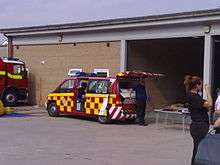
Incident command unit (ICU)
These vehicles perform the role of an on site control point, providing a single point of contact with the control rooms. The control units are mobilised to large or protracted incidents. Often, they are mobilised when four or more appliances are mobilised; or when the Incident Commander requests the attendance of additional appliances, taking the total to four or more. They control all communications on the incident ground and provide a single point of contact for the control room and Incident Commanders.
Environmental (EU) and incident support units (ISU) (Prime Mover)
These vehicles are used to provide logistical support to large incidents and carry additional equipment that compliments what is carried on front line appliances. They carry a large range of special equipment for controlling chemical spills and protecting the environment.
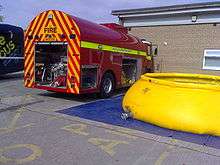
Water Carrier (WrC) Water foam carrier (WFC)
The Service uses a number of water carriers, which enable large quantities of water to be transported to support appliance in rural areas or where additional water is required. Each carrier holds 9,000 litres of water. A number of them also carry 1,000 litres (220 gallons) of firefighting foam.
Hose layer
The FRS has three Hose Laying Vehicles which are used to enable the pumping of water from a water source to support a large incident. Each hose layer carries almost 1.5 kilometres (0.9 mi) of hose.
Rescue vehicle
These vehicles carry a wide range of special equipment that is used to support operations at road traffic collisions and other rescue situations. They carry boats to provide water borne rescue capabilities, along with other equipment to assist at different rescue situations.
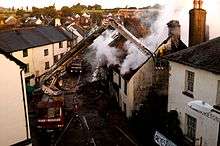
Aerial ladder platform (ALP)
Aerial Ladder Platforms, are located at strategic locations across the Service. They have a working height of 30 metres (98 ft) and are used both to carry out rescues from height, and also as firefighting platforms. They are also used to give firefighters safe access into fires. Occasionally they are also used to monitor a fire from above, or provide lighting.
Fireboat
The Fireboat "Vigiles" is located in Plymouth and is used to protect the Royal Naval Dockyard, the oil storage facilities and the commercial shipping that uses the port. Its high speed enables it to carry out a rescue role.
Off road appliances (WrT)
Due to the rural nature of Devon and Somerset, a number of vehicles are used that are capable of reaching fires that occur on the commons, moors and heathlands of the region. These all carry specialised firefighting equipment designed for the purpose. Cheddar and Dulverton each operate a Pinzgauer which is a specially built 6x6 vehicle. They are located to tackle tough terrains in their respective locations. The JCB Groundhogs at Porlock and Nether Stowey are high mobility fire fighting appliances. They are transported on a trailer to incidents that are difficult to access and operate usually in conjunction with the Pinzgauers and other off road vehicles.
Line rescue unit
Specially trained crews use these vehicles to carry out rescues on the cliffs and quarry faces across the region.
Support vehicles (L4Ps and L4Vs)
These vehicles are used to support operations by providing logistics and access in difficult terrain. In some cases they may be fitted with special fire fighting units called Brendon Pumps to support heath and moorland fires. At some rural stations they double up as Emergency Response units for co-responder roles.
Emergency response unit (EMS) (Co-responder vehicle)
Co-responder stations have a dedicated vehicle for co-responder calls so the fire appliance remains available. The vehicles are equipped with oxygen and automated external defibrillator (AED) equipment.

Incident response unit (IRU)
The Service operates four Incident Response Units (IRUs). They are stationed at Taunton, Okehampton and Bovey Tracey Fire Stations. They are supplied by the Department for Communities and Local Government, to respond to incidents involving mass decontamination - defined as incidents where more than one person can be decontaminated simultaneously using the same equipment. Each IRU is maintained by a host station with assistance from support stations which all receive training on the equipment at regular periods throughout the year. . See External links for more information on the IRU.
High volume pump (HVP)
The High Volume Pump has the capability of delivering large volumes of water over great distances utilising additional pumps. They can pump 7,000 litres/min and hose can be deployed utilising the 1 kilometre (0.62 mi) hose boxes at a maximum speed of 25 miles per hour (40 km/h). It also carries a variety of ancillary equipment including, hose adaptors, 5-way manifolds, Y-pieces, gate valves, non-return valves, water safety equipment, harnesses & lanyards, hose ramps, change of direction equipment, edge protection, sack trolley and lighting, cones and tape.
Urban search and rescue (USAR)
The Service has an Urban search and rescue team (USAR), one of 21 teams strategically located around England and Wales. They are equipped with five modules carrying varyious equipment to deal with a large range of incidents including structural collapse, large transport incidents, open area searches, heavy lifting operations, shoring and many more. The Urban Search and Rescue is station 60 and based at the Service's main headquarters, in Exeter.
British Red Cross Fire and Emergency Support Service (FESS)
The British Red Cross fire and emergency support service helps to meet the needs of individuals who have suffered damage to their homes following a domestic property fire, flood or similar emergency. Two units operating in Devon and Somerset based at the based Plymouth Red Cross Centre and Bridgwater Fire Station[5] are dedicated volunteers. What they do includes: providing refreshments, clothing, toiletries, use of an onboard telephone, first aid, sign-posting to other organisations, support with the care of children and pets, assistance in securing temporary accommodation, transport to friends/family and use of shower/washing and toilet facilities.
Operations
As part of the national FiReControl project, Devon and Somerset Fire and Rescue's control rooms were due switch over to a regional control centre in Taunton. Both control rooms were planned to cutover in May 2011,[6] but the plan was formally scrapped in December 2010 by the Government.[2]
Mutual assistance
The Fire and Rescue Services Act 2004, gives fire services the power to assist other fire services or fire authorities in what is known as mutual assistance.[7]
The fire services that adjoin the Devon and Somerset Fire and Rescue Service are as follows:
- Cornwall Fire and Rescue Service
- Dorset Fire and Rescue Service
- Wiltshire Fire and Rescue Service
- Avon Fire and Rescue Service
- Exeter International Airport Fire and Rescue Service
Children and young people
Devon and Somerset Fire and Rescue Service has a number of schemes for young people.[8]
They operate fire cadet schemes at Exmouth, Frome, Ivybridge, Newton Abbot, Totnes and Torquay fire stations, for boys and girls aged 11 to 17.
Firebreak is a personal development scheme for Key Stage 4 pupils (ages 14–16 years). It provides a novel Fire and Rescue Service themed educational diet designed to complement and enhance the school curriculum.
Firesetter Intervention programme is designed to address firesetting behaviour amongst children and young people up to the age of 19 years.
Phoenix is a six-month programme, primarily designed to reduce fire risk and fire related crime within local communities by working with 'at-risk' young people between the ages of 15–18 years.
See also
Other emergency services
- Devon Air Ambulance Trust
- Dorset and Somerset Air Ambulance
- Devon and Cornwall Constabulary
- South Western Ambulance Service
- Royal National Lifeboat Institution (RNLI)
References
- 1 2 "Brigade 'based on local response'". BBC News. 26 March 2007. Retrieved 2008-12-15.
- 1 2 "Control room scrapping 'will help Devon and Somerset". BBC News. 20 December 2010. Retrieved 21 December 2010.
- ↑ SWAST Fire Co Responders
- ↑ http://www.dsfire.gov.uk/AboutUs/WhatWeDo/OperationalResponse/Vehicles.cfm?SiteCategoryId=2&T1ID=10&T2ID=14&T3ID=14
- ↑ http://www.bridgwatermercury.co.uk/news/4054209.Red_Cross_unveil_new_emergency_van/
- ↑ http://www.swfirecontrol.co.uk/whatisfirecontrol.asp
- ↑ Fire and Rescue Act 2004
- ↑ http://www.dsfire.gov.uk/YoungPeople/Index.cfm?siteCategoryId=5
External links
| Wikimedia Commons has media related to Devon and Somerset Fire and Rescue Service. |